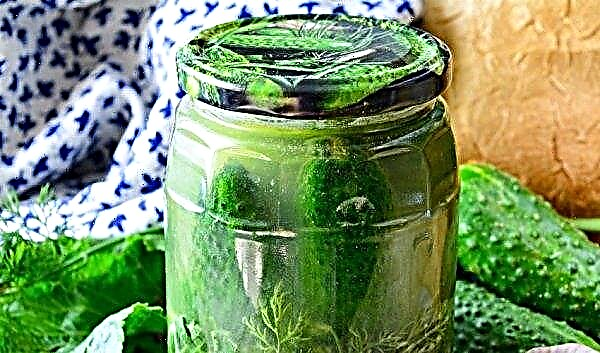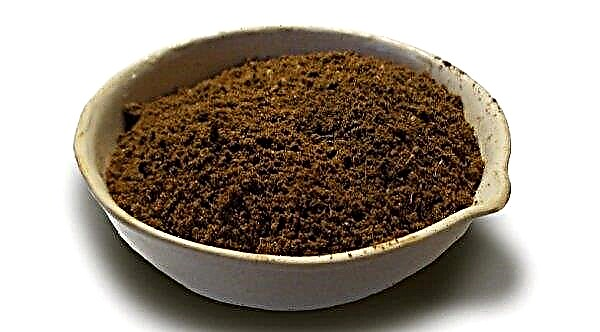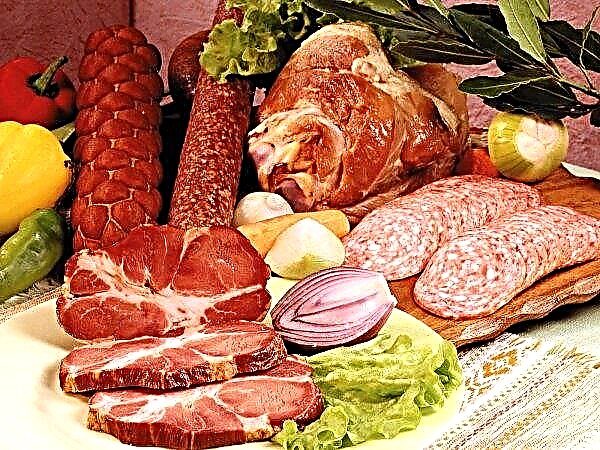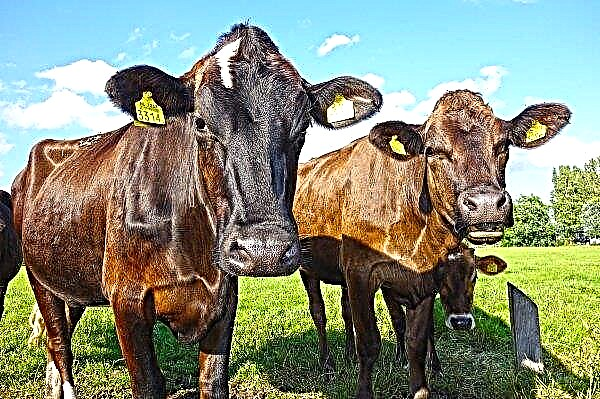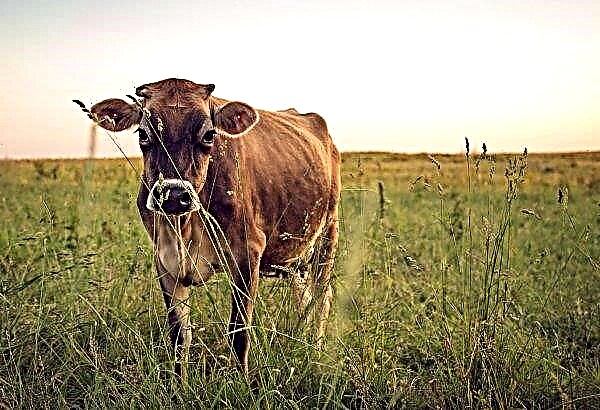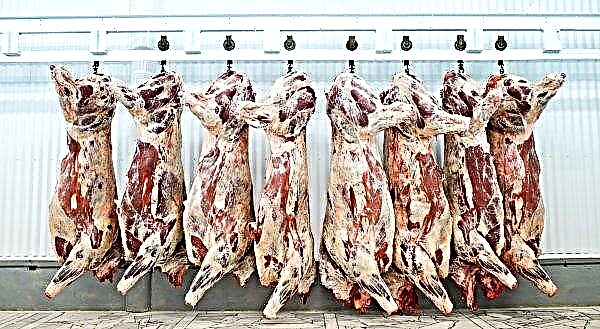Climbing roses have long occupied first places in landscaping. In addition to luxurious buds, flowers fill the space with a delicate pleasant aroma. One of such incredibly beautiful and fragrant varieties of roses called Jasmine will be discussed in our material.
Did you know? The oldest rose bush is about 1000 years old. It grows in Germany in the city of Hildesheim near the walls of the cathedral.
Description and characteristic
A powerful, leafy bush with a deep and well-developed root system extends along a support up to 2 m long. Thin flexible lashes with spikes form a compact crown up to 1 m wide. Leaves are oval in shape, with a carved edge and a sharp tip. The leaf plate is divided by a central vein. The surface of the sheet is glossy, dark green in color.
Each flowering brush forms up to 15 flowers, large, up to 10-12 cm in diameter, double. The flower is densely packed with petals in an amount of up to 70 pieces. The color of the petals varies from pale pink to lavender. The cupped flowers have a strong, but not heavy, pleasant aroma: someone smells jasmine or lilac in it, and someone distinguishes notes of a fresh green apple.
History of occurrence
The creators of the Jasmine rose are the breeders of the German family-owned enterprise for the selection of garden roses W. Kordes Sohne. The variety was bred in 2005, and after 3 years at the international flower competition Jasmine was awarded a gold medal.
Important! It is undesirable to plant a rose next to asters, peonies, irises, violets and cereal herbs. These plants depress her.
Distinctive features of the variety
One of the main advantages of the variety, unlike many, is the repeated flowering. The first period begins in May and lasts about a month. The bush is literally dotted with inflorescences forming mini-bouquets. The second period begins in August and lasts up to 2-3 weeks, however, only individual brushes bloom. A distinctive ability of the variety is resistance to shade and cold. Where other varieties start to hurt and refuse to bloom, Jasmine shows enviable resistance and even more magnificent flowering.
Features of planting and growing
Despite its resistance to low temperatures, Jasmine is afraid of a strong and gusty wind, so it should be planted on a site protected by buildings. A good solution would be the slope. When planting, consider the location of groundwater. The root system of the variety goes 2 meters deeper, so groundwater should lie even deeper so as not to flood the plant.
Did you know? An unusual variety of roses Chameleon was brought by the Japanese. In the daytime, its petals are bright red, and at night — white.
September will be the best time for planting: the bush will have time to adapt for the winter. Several plants are planted at a distance, given the width over which the bush subsequently grows. When planting, the growth point is buried 3 cm from the soil surface. After planting, the plant is watered, spending up to 30 liters of water under the bush.
Lighting Requirements
The ideal development of a rose is demonstrated by alternating bright lighting with a shadow. When choosing a place to land, preference is given to a site that is lit by the sun until noon. Constant exposure to direct sunlight will burn out the delicate petals and reduce flowering.
Soil quality requirements
The ideal composition of the soil should be light, loose and nutritious. The acidity index is 6–6.5 pH. Sandy and sandy loamy soils are too light.
Into the soil make:
- turf land;
- rotted manure;
- peat;
- lime.
Heavy clay soils also require correction, they are diluted by introducing:
- sand;
- compost;
- peat.
Important! If heavy rains occur during the flowering period, color shedding may be observed. If possible, provide bush with shelter.
Jasmine Rose Care
Plant care consists of standard watering and fertilizing and pruning procedures. To ensure vertical growth, you should immediately take care of the support.
Watering
Water for irrigation should not contain impurities from the main, its temperature should not be lower than + 18 ° С. Young specimens need watering twice a week, adult bushes - 1 time. In too hot weather, the interval between watering is reduced so that the roots do not dry out. Just under one bush spend up to 20 liters of water. By the end of September, watering is gradually reduced.
Fertilizer application
The first fertilizer is applied when planting per 1 m²: 8 kg of humus, 20 g of superphosphate and potassium salt, 200 g of wood ash. As the bush develops, top dressing is made as follows:
- at the end of May, the nitrogen composition is added: 20 g / 1 m²;
- at the end of June - nitrophosco: 20 g / 1 m²;
- in July, bushes are sprayed with magnesium sulfate: 20 g / 10 l of water;
- in August - superphosphate (40 g) and potassium salt (20 g / 1 m²).
Pruning
Every spring, pruning is carried out before the movement of juices. Remove weak and frozen shoots, dry branches. Cut at an acute angle to the 5-6th kidney located on the outside of the branch. In the fall, damaged or weak branches are also removed, and in addition to them, the bush is thinned out. Remove unpromising or knocked out of the crown lashes. Manipulations are carried out with a sharp disinfected tool.
Transfer
Garden roses usually grow in one place all their lives, depending on the variety, this can last 20–25 years. A transplant may be necessary if this site was unsuitable for any reason. Another reason may be saving the plant from the disease. It is recommended to perform the procedure at the end of summer, until the plant begins to prepare for wintering, or in the spring before the sap flow begins.
The transplant technology is as follows:
- Dig a trunk circle, carefully remove the plant.
- Remove damaged or dried root processes. Slices treated with powdered activated carbon.
- Prepare the landing site: apply fertilizer (the components are described above).
- When planting, straighten the roots of the plant, pour earth into the hole.
- Gently compact the soil and water.
Video: how to transplant a rose
How to prepare plants for winter
If the bush has grown enough, it must be removed from the support and bent to the ground. The trunk is usually spud up to a height of 40 cm. It is desirable to cut the foliage. Roses are covered with agrospan or other covering material. In a particularly cold climate, plants are additionally covered with needles, and after snow falls, it is thrown over the needles.
Breeding methods
All varietal characters of Jasmine can be preserved only when propagated by cuttings. The time for the procedure is the period of bud formation. As a material, take annual, developed, moderately thick shoots, cutting them at an acute angle from semi-lignified flowering lashes. A slice is made over the kidney at a distance of 1 cm, the slices on the parent shoot and the handle are treated with charcoal.
Rooting Technology:
- The lower cut of the cuttings, which will take root, is treated with a growth stimulator (Epin, Zircon).
- The soil is shed with a light pink solution of potassium permanganate.
- Seedlings are buried 2 cm at an angle, forming rows with a distance of 10 cm, between the cuttings - 6 cm.
- Top seedlings are covered with a glass or plastic greenhouse.
- A container with future roses is placed in a warm place (+ 22 ... + 25 ° С), with a humidity indicator of 80–90%.
- The earth is not watered, but moistened by spraying. Regularly ventilate the greenhouse.
- When the first leaves appear, the plants are tempered, removing the shelter with a gradual increase in time.
- Rooted seedling with developed leaves is transplanted to a permanent place.
Video: how to root a rose
Growing difficulties
If all the conditions for choosing a suitable site are met, the regime of watering and feeding is observed, then there will be no difficulties in growing a rose bush. However, there are unforeseen situations due to which the bush may become ill or be attacked by pests. The main problems and methods for solving them:
- Rust - bright orange spots on the inside of the sheet and brownish-orange spots on the outside. Fungal disease can be prevented by regular spraying of the bush during the growing season using Bordeaux fluid (100 g / 10 l). Treatment at all stages of development is carried out with the biological drug Alirin-B, watering the area around the bush with a solution in the proportion of 2 tablets per 10 liters of water.
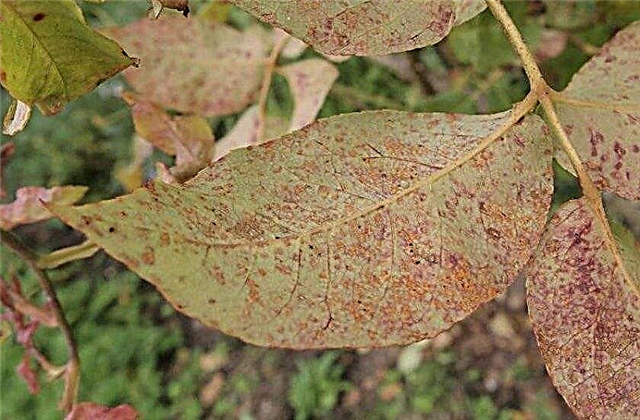
- Black spotting - dark spots on leaves with a yellow border. As a prophylaxis in the spring, they are sprayed with copper sulfate (1%). For the treatment of the disease, the biological drug Bactofit is used, with a solution of which the bush is watered in a proportion of 3 ml / 1 liter of water.

- Aphids, thrips - “Akarin” is effective against insects. From aphids use a mixture for spraying in a proportion of 6-8 ml / 1 l, from thrips - in a proportion of 8-10 ml / 1 l of water.
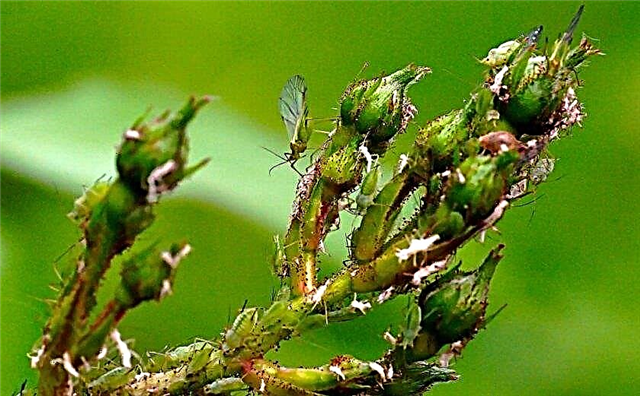
For vertical gardening, the Jasmine rose variety is ideal. Its cultivation is simple, and caring for it is not difficult. It is also noteworthy that freshly cut flowers stand in a bouquet for up to two weeks.




